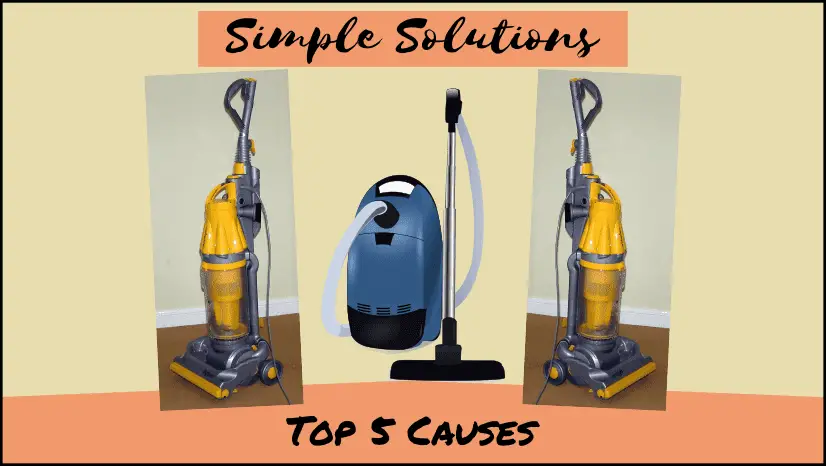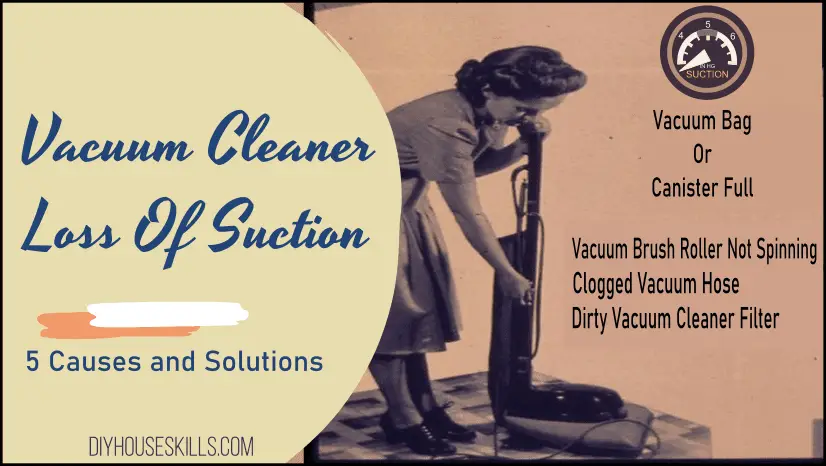This post is all about what causes a vacuum cleaner to lose suction and the top 5 causes with the solutions, so you can get your old vacuum working like new again.
Over time vacuum cleaners can and do lose suction, which means it’s not picking up as much dirt and dust as they used to. While you could go out and buy a new vacuum cleaner, it’s normally pretty easy to check just a few things to restore the loss of suction and get your vacuum as good as new.
This post will give you the top 5 causes of what causes a vacuum cleaner to lose suction and how to simply repair those issues. Plus I’ll provide some added bonus information about vacuums you might find interesting.
And be sure to check out my review of the top countertop ice makers, as well as Kitchen Knife Care: Do’s and Don’ts of Maintaining Knives. Or just want some general maintenance guides, I’ve got you covered with my other articles.
How To Fix Loss Of Suction In Vacuum Cleaners With Solutions And Tips:

Top 5 Causes:
1) Vacuum Bag Or Canister Full
It might seem obvious but start by checking if the bag or canister is full. A full bag can impede suction on a variety of vacuum cleaners. Unobstructed airflow is essential to the proper functioning and it is best to regularly check the bag or canister then empty after each use.
A bagless vacuum saves you the cost of buying bags, but you will need to purchase filters(or clean the filters if appropriate).
Canisters are easy to check as you can do a visual inspection. For a bag, feel the outside to determine how full it is, there should be a line across the outside indicating its full mark.
Solution:
So the simple thing is to go ahead and install a new bag or empty the canister.
2) Vacuum Brush Roller Not Spinning
If the vacuum cleaner roller not spinning is the issue, the vacuum will not be able to pick up dirt and debris. The most common cause of this is a broken or loose drive belt. You will need to refer to your specific model’s manual on how to remove and replace the belt. Generally, though, you unscrew and remove the base which then allows you to remove the brush roller. From there you will be able to access the belt and see how to replace it.
Another reason the brush roller isn’t spinning could be a buildup of hair and lint around the roller itself. Check the roller and remove any buildup you find, you might need to cut any hair or lint it it can’t be pulled out by hand.
Dyson Brush Not Spinning?
For most instances of a Dyson brush not spinning because it is jammed or stuck, you simply pull out the hair or debris from the brush bar. Some models allow you to remove the brush bar completely for cleaning. Since there are so many models, check the Dyson Troubleshooting website to look up your Dyson vacuum cleaner manual and model and the instructions on how you can fix the brush not spinning.
Solution:
Replace loose or broken drive belt as well as remove buildup of hair and debris from around roller brush.
≫Amazon.com has an extensive list of vacuum belts. Check their Best Sellers to find the belt you need. The average price is about $4US to $6US.
3) Clogged Vacuum Hose
Vacuums sometimes pick up larger debris that can get stuck and clog the hose. This will lead to loss of vacuum suction and probably make some amount of noise as the air tries to make its way through the hose. Start by feeling the hose to detect where the blockage is, if you can remove the hose and dislodge the debris go ahead and do so. If you are unable to locate the obstruction, A simple DIY vacuum hose solution. Get a stick or coat hanger wire to insert into the hose carefully and locate and remove any debris. Again, refer to your manufacturer’s manual for specific information on your model.
Solution:
Locate and remove debris or obstruction from the hose by feeling or carefully inserting a stick into the hose to locate and remove the item.
≫Amazon.com again has a wide selection of vacuum hoses. If you find you need to replace yours check their website.
4) Dirty Vacuum Cleaner Filter
Most vacuum cleaners have more than just one filter. They usually have a foam filter and a HEPA filter. Filters that are clogged will have a definite impact on the suction of the vacuum cleaner. Check and clean these filters regularly or every time you empty the canister or replace the bag.
Some foam filters can be washed and reused, but check your model’s manual to know for sure. HEPA filters will need to be replaced anywhere from 6 months to every year.
Solution:
Refer to your owner’s manual to identify the filters, then either clean them if appropriate or replace them if they are HEPA-type filters.
≫Amazon.com has a large selection of vacuum filters. Check their Best Sellers to find the filter that fits your brand vacuum. The price can vary from $7US to $15US.
5) Vacuum Cleaner Is Not Airtight
This one might be a little tricky to locate and fix. The vacuum cleaner needs to be airtight throughout to maintain good suction, that’s obvious. Not so obvious is determining where a leak might be coming from. If you have checked and resolved all the above issues then it is time to search for leaks or air gaps.
Leaks can be located in the hose as well as where two components fit together. Start by checking the hose, look for any breaks or punctures. Smaller breaks might be resolved by applying heavy tape or gluing the hose back together. A more serious break will require the hose to be replaced.
Secondly, examine where components come together, such as the canister seat. My Dyson vacuum has seals or gaskets at the canister, as well as around what they call the valve pipe, which is at the base of the vacuum. Whichever manufacturer’s vacuum you use, just check for these seals and clean them if needed.
Solution:
Examine and clean all the seals or gaskets between components as well as any breaks in the hose.
Bonus Info:
How Often Should I Vacuum My Carpet?
The answer to that question is it depends.. If you have pets in your home it might be necessary and a good idea to vacuum daily. This ensures you are removing pet hair and dander to provide a clean environment for you and your family.
Otherwise, vacuum at least once a week and sometimes twice a week if your carpets get a lot of foot traffic.
The professionals over at MerryMaids advise you to set a regular cleaning schedule and stick to it as well as taking your time vacuuming. Going too fast will not pick up all the dirt and just be a waste of time.
When Was The Vacuum Cleaner Invented?
According to Wikipedia.org:
Are Robot Vacuum Cleaners Any Good?
Robot vacuum cleaners can be run every day and are a good way to keep the floors clean. There are several models to choose and generally the cheaper ones will not be as effective as the more expensive models.
It should be noted that robot cleaners do not have the same power as your standard vacuum cleaner and as such will not pick up as much dirt. But as I said, these smaller robot vacuums can be run automatically every day without user intervention.
Summary,
So there are the most common reasons for a vacuum cleaner not picking up. We covered what causes a vacuum cleaner to lose suction and even talked about Dyson brush not spinning causes.
So there are the top 5 causes and their solutions to vacuum cleaner loss of suction issues.

